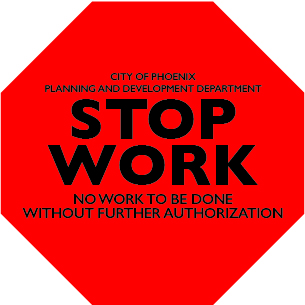Stop! In the Name of History
We’ve all seen them — red, octagonal stickers with the words “STOP WORK” stuck to the windows of homes that are under construction without a permit. The sticker instructs the homeowner to immediately stop any additional work and contact the city to obtain the proper permits. They appear when someone sees unpermitted work being done on a house and calls the city. While this may be frustrating to the homeowner, stop work orders are an especially important tool in historic districts because the neighborhood’s historic designation depends on homeowners maintaining the integrity of their property. The permit process includes a Historic Preservation (HP) review of the plans to make sure the proposed changes do not alter the historic integrity.

The City of Phoenix Historic Preservation philosophy states that it is important to preserve character-defining features of historic buildings through regular maintenance and repair, and replacing those elements using like materials and designs only when original elements cannot be repaired. Additions and alterations should not alter or obscure historical elements of the primary elevation (or front face) of the house. HP is primarily concerned with preserving the historic streetscape of the neighborhood. Any modifications to that streetscape need to be reviewed by HP staff and either given an over-the-counter “Certificate of No Effect” or require a public hearing for a “Certificate of Appropriateness” before the project proceeds. This applies to contributing and non-contributing properties within a designated historic district.
When we buy a home in a historic district, we become its steward. It’s a huge responsibility and one most of us are proud to bear, and for which we are rewarded with a significant reduction (up to 49%) of our property taxes. However, the consequences of unapproved construction projects can have multiple effects. The homeowner may be required to remove the offending alteration and may also lose their tax credit. A larger consequence is that if too many homes within a district become “non-contributing,” meaning they have been altered to a point that they no longer retain their historic integrity, the entire district is in danger of being delisted from the National Register of Historic Places. This would mean that all residents in that district would lose their tax credit and property values would likely go down.
So why do we see Stop Work Orders in our neighborhoods? In most cases, I believe, the homeowner is unaware of the “rules.” In some cases, they point to another house with a similar modification as justification. But remember, many of those alterations were made before the neighborhood became a historic district. Another reason is that people do not want to “alert” HP that they are making changes to their homes. They see HP as their enemy who doesn’t want any changes to be made. This couldn’t be further from the truth. When you are in the planning stage of your project, connect with HP to see if your project is allowable. If it isn’t, they may have alternative suggestions. Doing this will not “flag” your home so that city inspectors will keep an eye on you — they don’t have the budget or the manpower to do that. And yes, it means you will have to get a permit for your project. Just remember, permits protect your home’s value and ensures proper construction standards are followed.